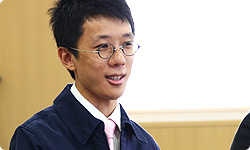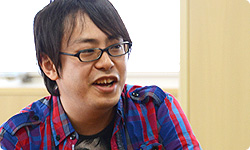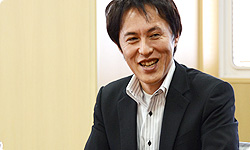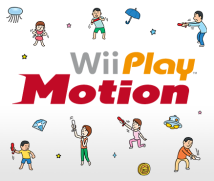6. Bursting with Variety
I’d like to hear how the final product looks to you with regard to the possibilities you sense in the Wii Remote Plus and how difficult it is. Ebisu-san, would you go first, please?
At Good-Feel, we had a hard time matching the Wii Remote Plus controller’s motion sensor and human motion.
The Wii Remote Plus is high-performance, but it has certain characteristics, so it isn’t easy to fully get the hang of it.
Human beings move in so many different ways. In Veggie Guardin’, for example, you may think that you’re swinging straight from the front, but actually you’re moving the controller at an angle. We had to account for such error.

Every time, you have to bring the hammer down where you’re aiming. But I think you drew out various other ideas possible only because it comes with the Wii Remote Plus. How about you, Mizobe-san?
With the Wii Remote Plus you can have fun that wasn’t possible before. I think Star Shuttle is a good example of a new kind of gameplay that wasn’t possible with the original Wii Remote. Overall, there are all kinds of games - games you play sitting down, games like Veggie Guardin’ that require using your whole body, and games you play off the screen.

How about you, Funaki-san?
We made use of the unusual action of twirling the Wii Remote Plus, which caused Nintendo some trouble. If you twirl it too fast, you get tired, so adjusting that was hard.
It was hard because of that unique method of game operation. Was it hard reading the signal from the Wii Remote Plus as real movement?
We had to make the movements to take into account the bodily error, so the experimental stage was really hard. But once it was done, I felt like it came together.

Niitani-san?
There’s a small gap between the feeling of swinging your hand and what occurs on the screen. There’s a gap in the hardware itself and in the way it feels to the players, so our foremost challenge was getting as close as possible to having it move exactly the way it feels. But even if it felt right to me, different people swing the controller different ways. In the end, though, I think we made game operation the way we wanted. It’s also important that there’s sound and vibration, too.

How did it look to you, Hosokawa-san?
I took a step back and looked at it from the point of view of the players. I don’t think most players are very aware of whether they’re holding the Wii Remote or the Wii Remote Plus. So I tried to make play control as straightforward as possible. In the end, I think whether you’re talking about controls or the game elements, in whichever minigame, it’s a rewarding product.

How about you, Eto-san?
In Flutter Fly, people wave their fans in completely different ways, but the motion sensor reads their movements extremely accurately, so it was hard bringing everyone’s motions together. But I think it came together rather nicely in the end.

In everyday life, you wouldn’t usually think about all the different ways people wave fans. (laughs) And you, Taniguchi-san?
Luckily for us, however you hold the controller, the behaviour of the umbrella doesn’t change, so we were able to finish relatively early on. But for us, there were so many possibilities with the Wii Remote Plus that we weren’t sure which features to focus on. But I think the final result was perfect!

How about you Naka-san?
I think Trigger Twist and Good-Feel’s Veggie Guardin’ are the two games that are the least lenient. The precise motions of the Wii Remote Plus are directly apparent, so especially if you’re pointing the Wii Remote Plus somewhere off-screen, when you come back to the screen, if the response of the pointer on the screen is off, it’s really displeasing.

In that way, you were able to achieve a rewarding degree of precision in a game that isn’t very lenient. How about you, Ohshima-san?
In Spooky Search, we had trouble making it so the pointer wouldn’t be off. In the end, it turned out so children can have plenty of fun playing it in a big room. When it comes to Cone Zone, you can sort of imagine stacking up ten and balancing them, but you can pile them all the way into outer space! (laughs) It was hard to figure out how to turn that into a game involving three-dimensional movement. (laughs)

How do you feel it turned out?
I think it turned out great. Including everyone’s minigames, I think it’s fun like nothing before and is bursting with variety.
Just as suggested by the name in Japanese - Wii Remote Plus Variety Pack - it’s bursting with variety. Nonaka-san, could you say a few words about the title?
At first, we were going to call the Japanese version My First Wii Remote Plus, but then we changed to Wii Remote Plus Variety Pack. At first we conceived of it as a sequel to My First Wii (as the Japanese title of Wii Play).

Right. But it’s been so long since the Wii console came out that we weren’t sure it made any sense to use the words “My First.” This game isn’t just targeting people who are playing for the first time.
So we started talking about changing the title, tossed around ideas, and decided on one.
I decided to overturn my own decision about the title when (Shinji) Hatano-san - general manager of the Nintendo Marketing Division - said, “Can we really say ‘My First’ at this point?” When this project first arose, My First Wii Remote Plus may have seemed like the natural title, but we were also sort of naming it out of force of habit. At the same time, this had turned out to be a rather substantial game, so I wanted to represent that in the title somehow. In the end, I’m really glad I changed the title.
